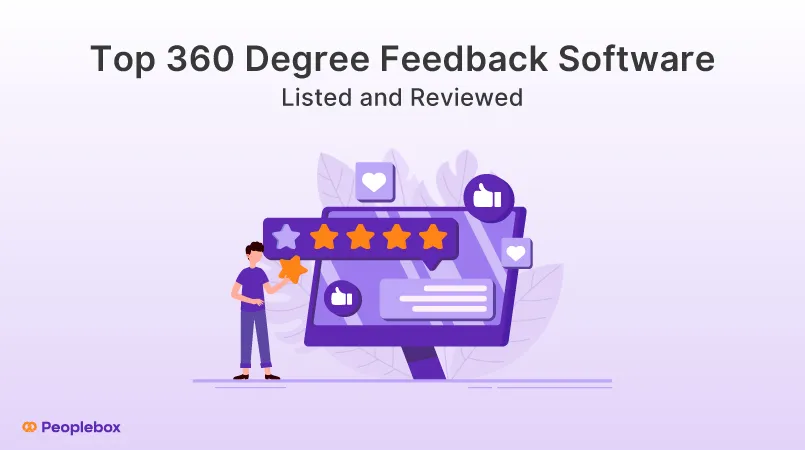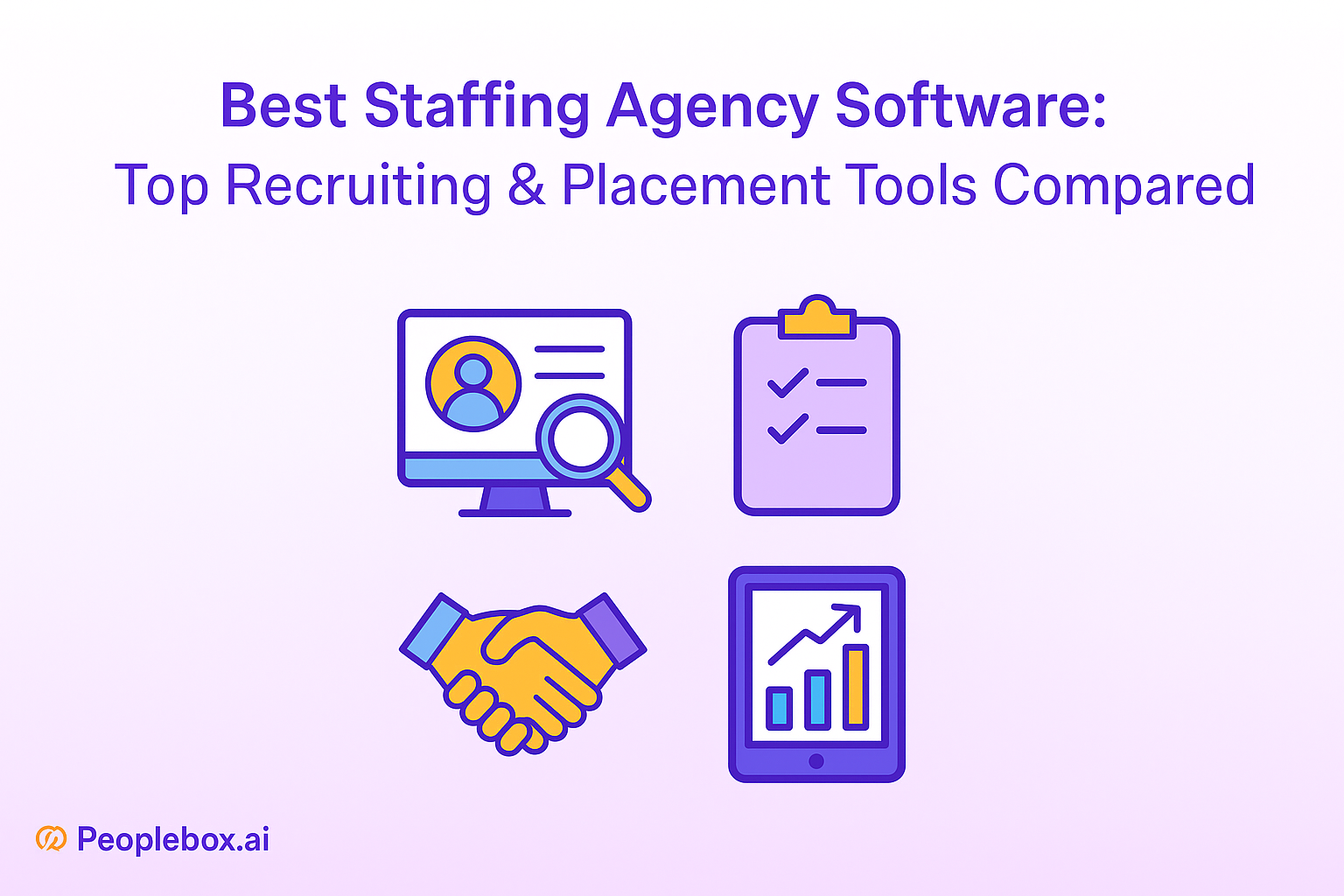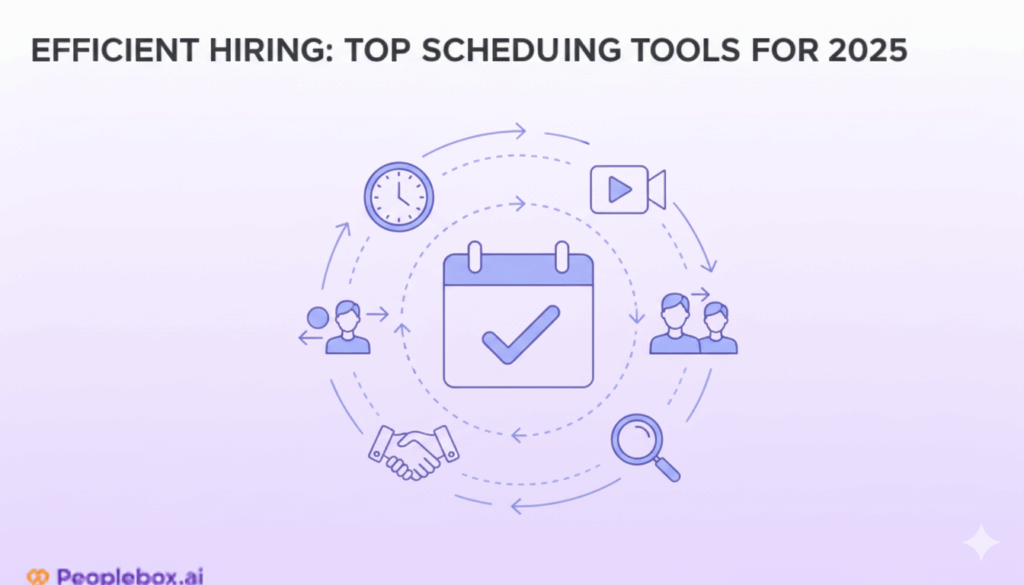
Ready to explore 360-degree feedback tools in detail? Let’s get you started!
Here is a numbered list of the top 30 best 360-degree feedback tools with a brief description of each, based on the latest insights and features available in 2025:
1. Peoplebox.ai
Offers seamless Slack and Microsoft Teams integration, enabling continuous feedback cycles and goal tracking within collaboration platforms.
| Category | Details |
| Best For | Companies wanting OKRs, 1:1s, performance reviews and 360 feedback inside Slack or Teams. |
| Pricing | From $7/user/month |
| Free Plan | No |
| Key Features | OKRs, 1:1 meetings, 360 feedback, performance reviews, Slack/MS Teams integration. |
| Ideal Team Size | 50–500 employees |
| Ease of Use | Simple |
| Deployment Time | Same day, no learning curve (read what our customers say) |
| Integration Strength | Strong (Slack, MS Teams, HRIS APIs) |
| Why You Might Choose It | Perfect if your team lives in Slack/Teams and you want continuous feedback tied to goal setting. |
| Potential Drawbacks | No free plan. |
| Most 360-degree feedback tools create extra work—forcing teams to juggle separate platforms just to share feedback, review goals, and run performance cycles. The best feedback platform should meet your team where they work (like Slack or Microsoft Teams), helping feedback flow naturally and staying tied to clear goals. That’s exactly what Peoplebox.ai is built for: integrating performance reviews, OKRs, and feedback cycles into the tools your teams already use daily. See how Peoplebox.ai simplifies 360 feedback → |
2. Lattice
Popular for its performance management suite, Lattice includes 360 feedback with goal setting and real-time insights.
| Category | Details |
| Best For | Companies needing full performance management, 360 feedback, and engagement tracking. |
| Pricing | Custom (typical ~$11–$15/user/month) |
| Free Plan | No |
| Key Features | 360 feedback, performance reviews, OKRs, engagement surveys, career tracks. |
| Ideal Team Size | 100–5,000 employees |
| Ease of Use | Medium (requires onboarding) |
| Deployment Time | 4–6 weeks (with help) |
| Integration Strength | Very strong (HRIS, Slack, Teams, ATS systems) |
| Why You Might Choose It | Ideal if you want deep analytics, career development tracking, and rich feedback loops. |
| Potential Drawbacks | Expensive for very small teams; needs HR support for setup and scaling. |
3. SurveyMonkey
Enterprise-grade survey platform with extensive 360-degree feedback templates, advanced analytics, and strong security features for scalable performance management.
| Category | Details |
| Best For | Organizations needing flexible, quick feedback collection without a full HR system. |
| Pricing | ₹4,999/month and up |
| Free Plan | Yes (limited survey features) |
| Key Features | 360 survey templates, advanced branching logic, analytics, benchmarking. |
| Ideal Team Size | 10–5,000 employees |
| Ease of Use | Very simple |
| Deployment Time | 1–3 days |
| Integration Strength | Medium (basic HRIS and CRM integrations) |
| Why You Might Choose It | Best for running lightweight 360 surveys quickly without buying a big HR platform. |
| Potential Drawbacks | Purely a survey tool — no built-in OKRs, goals, or coaching support. |
4. Leapsome
Combines 360-degree feedback with performance management and employee engagement, offering customizable surveys and actionable analytics ideal for mid-sized businesses.
| Category | Details |
| Best For | Companies needing integrated performance, 360 feedback, and learning tools. |
| Pricing | Custom pricing (usually $8–$12/user/month) |
| Free Plan | No |
| Key Features | 360 feedback, engagement surveys, OKRs, learning paths, performance reviews. |
| Ideal Team Size | 50–2,000 employees |
| Ease of Use | Medium (admin setup needed) |
| Deployment Time | 3–5 weeks |
| Integration Strength | Strong (Slack, MS Teams, HRIS, SSO) |
| Why You Might Choose It | Great if you want a people development engine tied to feedback. Fully customizable templates. |
| Potential Drawbacks | Takes some time to configure if you want to heavily personalize processes. |
5. Deel
Best suited for global organizations, Deel integrates 360 feedback with HR and payroll systems to streamline performance reviews across borders.
| Category | Details |
| Best For | Global teams needing payroll + HR compliance + 360 feedback in one. |
| Pricing | Custom |
| Free Plan | No |
| Key Features | 360 feedback, HRIS features, compliance management, international payroll. |
| Ideal Team Size | 200+ employees, remote-first companies |
| Ease of Use | Medium (onboarding and compliance require support) |
| Deployment Time | 6–8 weeks (due to legal and HR complexities) |
| Integration Strength | Strong (HRIS, financial systems, Slack) |
| Why You Might Choose It | If you’re scaling internationally and need both 360 feedback and full compliance. |
| Potential Drawbacks | Overkill if you’re only in 1–2 countries; expensive for smaller orgs. |
6. 15Five
Lightweight and user-friendly, 15Five combines 360 feedback with OKR tracking and coaching tools for continuous development.
| Category | Details |
| Best For | SMBs focused on employee coaching, feedback, and OKR tracking. |
| Pricing | From $7/user/month |
| Free Plan | No |
| Key Features | 360 feedback, 1:1s, OKRs, engagement surveys, coaching plans. |
| Ideal Team Size | 25–1,000 employees |
| Ease of Use | Simple |
| Deployment Time | 1–2 weeks |
| Integration Strength | Good (Slack, HRIS, project management tools) |
| Why You Might Choose It | Excellent for building continuous feedback culture and lightweight performance reviews. |
| Potential Drawbacks | May lack complex enterprise-grade workflows if you’re scaling fast. |
7. Culture Amp
Integrates employee engagement with 360 feedback and talent analytics, ideal for large teams focused on culture.
| Category | Details |
| Best For | Organizations serious about culture building and deep feedback analytics. |
| Pricing | Custom (typically ~$11–$15/user/month) |
| Free Plan | No |
| Key Features | 360 feedback, engagement surveys, DEI surveys, onboarding/exit surveys, analytics dashboards. |
| Ideal Team Size | 100–5,000 employees |
| Ease of Use | Medium (requires admin training) |
| Deployment Time | 5–7 weeks (with dedicated support) |
| Integration Strength | Very strong (HRIS, Slack, Teams, ATS) |
| Why You Might Choose It | Perfect if you want feedback tied to real cultural improvement and deep action planning. |
| Potential Drawbacks | Complex setup; better for companies with a People Ops team in place. |
8. BambooHR
Intuitive HRIS with built-in 360 feedback, customizable review cycles, and centralized data management.
| Category | Details |
| Best For | Small to mid-sized businesses needing intuitive HRIS with integrated 360 feedback. |
| Pricing | From ~$99/month for small teams (custom pricing for larger organizations). |
| Free Plan | No |
| Key Features | 360 feedback, performance management, customizable review cycles, HRIS, centralized data management, reporting. |
| Ideal Team Size | 50–1,000 employees |
| Ease of Use | Very simple and intuitive |
| Deployment Time | 2–4 weeks |
| Integration Strength | Strong (HRIS, payroll, and benefits management) |
| Why You Might Choose It | Excellent if you want an all-in-one HR tool that integrates 360 feedback seamlessly with other HR functions. |
| Potential Drawbacks | Best suited for small to mid-sized businesses; lacks the complexity some large organizations need. |
9. Engagedly
Combines multi-source feedback with rewards and recognition features, focusing on employee motivation and development.
| Category | Details |
| Best For | Organizations wanting to combine multi-source feedback with recognition and rewards. |
| Pricing | From ~$4/user/month |
| Free Plan | No |
| Key Features | 360 feedback, performance management, employee engagement, rewards, recognition, continuous feedback, surveys. |
| Ideal Team Size | 100–5,000 employees |
| Ease of Use | Medium |
| Deployment Time | 4–6 weeks |
| Integration Strength | Medium (Slack, Teams, HRIS) |
| Why You Might Choose It | Great if you’re looking to enhance employee motivation alongside gathering feedback. Combines multiple features in one platform. |
| Potential Drawbacks | Can feel complex for smaller teams or organizations focused only on feedback. |
10. Workday
Enterprise-grade HR platform with integrated 360 feedback, performance management, and analytics.
| Category | Details |
| Best For | Large enterprises requiring an integrated HR platform with 360 feedback capabilities. |
| Pricing | Custom (enterprise-level pricing based on modules and employees) |
| Free Plan | No |
| Key Features | 360 feedback, performance management, talent management, learning & development, compensation, HRIS, analytics. |
| Ideal Team Size | 1,000+ employees |
| Ease of Use | Medium to complex (requires training for full use) |
| Deployment Time | 3–6 months |
| Integration Strength | Very strong (integrates with finance, payroll, and other HR systems) |
| Why You Might Choose It | Choose Workday if you need a robust, all-in-one platform that integrates feedback with broader HR functions at an enterprise scale. |
| Potential Drawbacks | Expensive and potentially overkill for smaller businesses or those only needing 360 feedback. |
More 360-degree Feedback Softwares in The Market:
- Empuls
Affordable and user-friendly, Empuls combines employee engagement with 360 feedback features to enhance workplace culture.
- HRMantra
Provides a comprehensive HR suite with integrated 360-degree feedback, focusing on customizable workflows and detailed reporting.
- Mercer Mettl 360View
Known for its robust assessment capabilities, Mercer Mettl offers multi-rater feedback with advanced analytics and benchmarking.
- Qaizenx
A flexible platform that supports continuous feedback and performance management with customizable 360 feedback templates.
- Namely
An all-in-one HR platform with built-in 360-degree feedback tools, focusing on ease of use and employee development.
- Qualtrics
Provides an intuitive interface with customizable 360 feedback surveys and powerful reporting, linking results to learning resources.
- Primalogik
Simplifies the 360 feedback process with automated reminders, anonymous feedback collection, and easy-to-understand reports.
- PerformYard
Integrates 360 feedback into performance management with customizable questionnaires and goal tracking features.
- Synergita
AI-powered platform designed for SMBs, offering customizable workflows and detailed feedback analytics.
- Mitratech Trakstar
Offers comprehensive 360-degree reviews, goal management, and performance tracking with multi-source feedback collection.
- WorkTango
Scalable platform for mid-market and enterprise clients, offering strong analytics and engagement tools alongside 360 feedback.
- eloomi
Blends learning management with 360 feedback, enabling continuous development through integrated training and reviews.
- agyleOS
Focuses on agile performance management with customizable 360 feedback and real-time insights.
- Bonrepublic
Provides a simple, user-friendly 360 feedback tool with anonymous surveys and easy reporting.
- Personio
Automates performance cycles including 360 feedback, supporting continuous feedback culture within organizations.
- Keka
Comprehensive HRMS solution with 360-degree feedback features and customizable review workflows.
- TalentGuard
Offers talent management with 360 feedback, succession planning, and career pathing tools.
- Qualaroo
Advanced survey tool with skip logic and sentiment analysis, suitable for detailed 360 feedback surveys.
- ProProfs Survey
Extensive survey templates and customization options, enabling detailed 360 feedback collection and analysis.
- PeopleGoal
Focuses on boosting performance and engagement with customizable 360 feedback and trial options for new users.
Final Thoughts: Choosing the Right 360-Degree Feedback Tool
Choosing the right 360-degree feedback tool isn’t just about features—it’s about finding a platform that matches your company’s size, culture, and performance goals.
Some tools are perfect for continuous, informal feedback inside collaboration apps like Slack or Teams (like Peoplebox.ai). Others offer deeper talent analytics and performance management (like Lattice and Culture Amp).
The best advice?
Start with your end goal in mind.
Whether you’re aiming for lightweight check-ins or full-scale development plans, the right software will make feedback a powerful engine for growth, not a burden on your teams.
If you’re ready to turn feedback into real performance improvement, explore the tools listed above and pick the one that fits your needs today—and scales with you tomorrow.
Frequently Asked Questions (FAQs)
1. What is a 360-degree feedback tool?
A 360-degree feedback tool collects performance input from managers, peers, direct reports, and sometimes external partners. It offers a comprehensive view of an employee’s skills, behaviors, and development needs, beyond just manager observations.
2. How is 360 feedback different from traditional performance reviews?
360 feedback incorporates multiple perspectives, while traditional reviews focus only on manager input. This broader lens helps surface hidden strengths and areas for improvement that a single manager might miss.
3. Who should participate in a 360-degree feedback process?
Participants typically include a manager, 3–5 peers, direct reports, and cross-functional colleagues. A balanced reviewer group ensures feedback is fair, diverse, and actionable.
4. How often should 360-degree feedback be conducted?
Most organizations run 360 feedback annually for leadership roles and high-potential employees. Quarterly or semi-annual cycles are ideal for fast-growth teams that prioritize continuous development.
5. What features should you prioritize in a 360 feedback tool?
Look for customizable templates, anonymous feedback settings, intuitive reporting, integrations with HR systems, and built-in goal tracking to turn feedback into growth plans.
6. Can small companies benefit from using 360 feedback?
Yes, small companies often gain even more from 360 feedback because it accelerates leadership development, strengthens team dynamics, and identifies issues early while the organization is still scaling.
7. How do you ensure fairness in 360-degree feedback?
Fairness comes from selecting a diverse group of raters, using standardized survey questions, anonymizing feedback, and training employees on how to interpret and act on results constructively.
8. Are 360 feedback responses anonymous?
Yes, most modern platforms anonymize peer and direct report feedback to encourage honesty and minimize fear of retaliation, leading to more authentic insights.
9. Do 360 feedback tools integrate with HR systems like HRIS and Slack?
Leading 360 feedback tools offer seamless integrations with HRIS platforms, Slack, Microsoft Teams, and other systems to embed feedback into daily workflows and simplify performance management.
10. What’s the biggest mistake companies make with 360 feedback?
The biggest mistake is gathering feedback without structured follow-up. Without coaching conversations and development plans, 360 feedback becomes a checklist exercise instead of a driver of growth.
11. Is 360-degree feedback useful for promotions?
Yes, 360 feedback gives a fuller picture of leadership potential, emotional intelligence, and peer influence—factors that often matter more than task performance alone when evaluating promotions.
12. How long does it take to complete a 360 review?
On average, employees spend 10–20 minutes per review, depending on the survey length. Shorter, focused surveys drive higher completion rates and better feedback quality.
13. Should 360-degree feedback be used for performance ratings?
360 feedback is better suited for development than for formal ratings. Using it strictly for evaluation can create fear and bias the feedback, limiting its value.
14. Can employees choose their own raters for 360 feedback?
Some programs allow partial self-selection with manager oversight to ensure fairness. Balanced rater groups improve credibility and minimize potential bias.
15. What’s the ROI of investing in a 360 feedback tool?
The ROI comes from faster leadership development, improved retention, stronger team performance, and early identification of skill gaps—outcomes that directly impact business growth.






